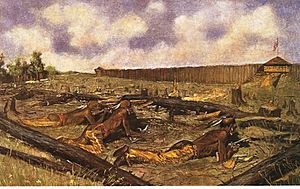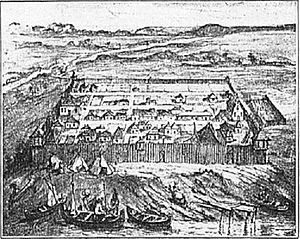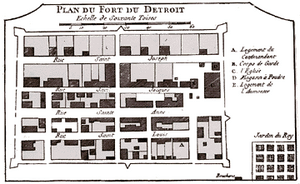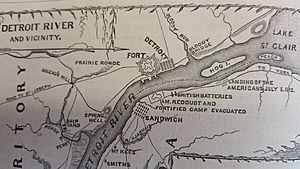Fort Detroit facts for kids
Quick facts for kids Fort Détroit |
|
|---|---|
| Detroit, Michigan | |

1763 siege of Fort Detroit
|
|
| Type | Fort |
| Site information | |
| Controlled by | |
| Site history | |
| Built | 1701 |
| In use | 1701–1796 |
Fort Pontchartrain du Détroit, also known as Fort Detroit, was an important fort built by the French in 1701. It was located on the west bank of the Detroit River by a French officer named Antoine de la Mothe Cadillac. In the 1700s, French settlements grew on both sides of the river. These settlements were important for the fur trade, religious missions, and farming.
Today, the area where the fort once stood is part of the city of Detroit in Michigan, United States. It's a busy area with office buildings.
The British took control of the fort in 1760 during the French and Indian War. They held it until the American Revolutionary War. After the war, the United States took over the fort. The British also built another fort nearby, called Fort Lernoult, in 1779. This fort was later renamed Fort Shelby and was used by the US military until the 1820s. The city of Detroit tore down Fort Shelby in 1827.
Contents
History of Fort Detroit
The river between Lake St. Clair and Lake Erie was known as le Détroit, which means "the Strait" in French. In 1701, Cadillac decided to build a fort on the west side of this river. His goal was to stop British colonists from moving west and to control the valuable fur trade in central North America.
Cadillac had previously been in charge of another French outpost called Fort de Buade. That fort was closed in 1697 because of disagreements about trade practices with Native American communities. Cadillac convinced his leaders to let him build a new settlement. He arrived at the Detroit River on July 23, 1701.
When Cadillac landed, he held a ceremony to officially claim the area for France. He named the new settlement Fort Pontchartrain du Détroit. This name honored Louis Phélypeaux, Comte de Pontchartrain, who was a minister to the French king Louis XIV. Building started right away. The first building finished was Ste. Anne's Catholic Church. The fort's walls, made of logs with defensive towers, were the second structure to be completed.
After the fort was built, some Odawa and Huron tribes settled nearby. They wanted to trade easily with the French. A French religious mission for the Huron was set up across the river. This area grew into a French settlement called Petite Côte, which is now part of Windsor, Ontario.
Conflicts at the Fort
The first major conflict at Fort Detroit happened in March 1706 when Cadillac was away. The Odawa tribe heard a rumor about an ambush by the Huron. The Ottawa attacked and killed several members of the Miami tribe. The Miami sought safety inside the fort, where French soldiers defended them. The French killed about 30 Ottawa warriors who attacked the fort. After this, the Miami attacked an Ottawa village. During the fighting, a French priest and a soldier who were outside the fort walls were killed.
The fort's commander, Étienne de Veniard, Sieur de Bourgmont, was criticized for how he handled the situation. When Cadillac returned, Bourgmont and some soldiers left the fort without permission.
Bourgmont lived with Native Americans for a time. He married a Native American woman and had a child with her. In many Native American tribes, children were considered part of their mother's family and clan. This meant Bourgmont's mixed-race children were raised in the tribal culture.
In 1718, the French government honored Bourgmont with the Order of Saint Louis. He was recognized for being the first European to map the Missouri River and Platte River. He also helped convince Native American tribes to support the French against the Spanish.
Cadillac was later removed from his position. In 1712, Jacques-Charles Renaud Dubuisson officially became the new commander at Fort Detroit.
When the Fox tribe heard about the change in command, they planned an attack on the fort. Many of Cadillac's Native American supporters had left. In late April 1710, about 1,000 Fox, Sac, and Mascouten warriors surrounded the fort. The Ottawa and Huron warriors were away on a raid and could not help the French. Jean Baptiste Bissot, Sieur de Vincennes, a French commander from another outpost, and seven fur traders managed to sneak into the fort. Dubuisson sent messages to the Ottawa and Huron, who then returned to help.
The Fox and their allies found themselves trapped between the French and their enemies. They were surrounded until the end of May. They then fled to an area now called Windmill Point. The French and Huron warriors followed them. After four days, the Fox surrendered to protect their families. The French agreed, but after the Fox were disarmed, the French attacked and killed many of them. This event is sometimes called the Fox Indian Massacre. This siege of Fort Detroit was the start of the Fox Wars.
British Takeover
After years of conflict between the British and French in North America, the French and Indian War began in 1754. Fort Detroit was far from the main battles and was not directly involved in the fighting. However, two months after the French surrendered in Montreal in 1760, Fort Detroit was given to the British Army on November 29, 1760.
British rule was different from French rule in several ways. The British asked for higher taxes and took away weapons from settlers they considered "unfriendly," which included many French Canadians. The British also refused to sell ammunition to French Canadians or Native Americans who had traded with the French. The French traders had given guns to many of their trading partners for years. These British changes made it harder for Native Americans to hunt and trap. The British colonists did not focus on keeping good relationships with Native Americans. In contrast, French Canadians had often married into Native American families and understood their customs, like giving gifts.
After the French left the conflict, Pontiac, an Ottawa war leader, united several tribes in what became known as Pontiac's Rebellion. He tried to capture Detroit from the British on May 7, 1763. They failed to capture the fort because the British knew about the attack beforehand. However, they did surround the fort in a long siege.
The British force inside the fort, led by Henry Gladwin, had 130 soldiers and several cannons. A ship called the Huron was anchored nearby in the Detroit River. Two months into the siege, on July 29, 1763, the British brought a large group of reinforcements. Fighting continued in the area, including the Battle of Bloody Run, until mid-November when the Native American warriors left.
During the American Revolutionary War, Detroit was far to the west of the main fighting. The British used the fort to arm Native American raiding parties. These parties attacked American rebel settlements to the southeast. American revolutionaries, especially George Rogers Clark, hoped to lead an expedition to Detroit to stop these attacks. However, they could not gather enough men for the attempt. Clark did manage to capture Henry Hamilton, a British leader at Fort Detroit, when he traveled south to Fort Sackville.
United States Takes Control
In late 1778, while Hamilton was a prisoner, Captain Richard B. Lernoult began building a new fort. This new fort was a few hundred yards north of the original Fort Detroit. It was named Fort Lernoult on October 3, 1779. This new fort largely replaced the original one and was often called "Fort Detroit" itself.
After the United States won its independence, the government signed the Treaty of Greenville in 1795 with several Native American tribes. In this treaty, the tribes gave up several areas of land to the United States, including the area around Detroit.
On July 11, 1796, under the terms of the Jay Treaty, the British finally handed over Fort Detroit, Fort Lernoult, and the surrounding settlement to the Americans. This happened 13 years after the Treaty of Paris officially ended the war and gave the area to the United States.
Some records suggest that only Fort Lernoult survived the great fire of 1805, which destroyed most of Detroit. It seems that no part of the original Fort Detroit remained after this fire. Fort Lernoult was officially renamed Fort Detroit in 1805, and then Fort Shelby in 1813. After the military stopped using it, the city of Detroit tore down Fort Shelby in 1827.
Location Today
The second Hotel Pontchartrain, now called the Crowne Plaza Detroit Downtown Riverfront, stands on the former site of the fort. A special Michigan Historic Marker for Fort Pontchartrain is located at the southwest corner of the Crowne Plaza, at Jefferson Avenue and Washington Boulevard.
See also
 In Spanish: Fort Detroit para niños
In Spanish: Fort Detroit para niños




